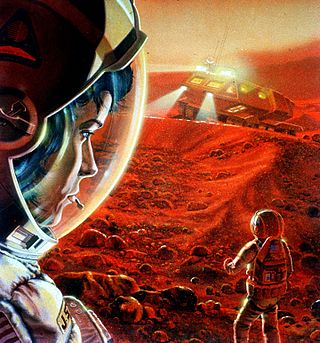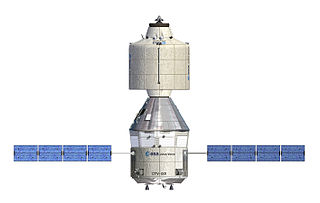Related Research Articles

The European Space Agency (ESA) is a 22-member intergovernmental body devoted to space exploration. With its headquarters in Paris and a staff of around 2,200 people globally as of 2018, ESA was founded in 1975. Its 2024 annual budget was €7.8 billion.

A spacecraft is a vehicle that is designed to fly in outer space and operate there. Spacecraft are used for a variety of purposes, including communications, Earth observation, meteorology, navigation, space colonization, planetary exploration, and transportation of humans and cargo. All spacecraft except single-stage-to-orbit vehicles cannot get into space on their own, and require a launch vehicle.

The Automated Transfer Vehicle, originally Ariane Transfer Vehicle or ATV, was an expendable cargo spacecraft developed by the European Space Agency (ESA), used for space cargo transport in 2008–2015. The ATV design was launched to orbit five times, exclusively by the Ariane 5 heavy-lift launch vehicle. It effectively was a larger European counterpart to the Russian Progress cargo spacecraft for carrying upmass to a single destination—the International Space Station (ISS)—but with three times the capacity.

Hermes was a proposed spaceplane designed by the French Centre National d'Études Spatiales (CNES) in 1975, and later by the European Space Agency (ESA). It was superficially similar to the American Boeing X-20 Dyna-Soar and the larger Space Shuttle.

A spaceplane is a vehicle that can fly and glide like an aircraft in Earth's atmosphere and maneuver like a spacecraft in outer space. To do so, spaceplanes must incorporate features of both aircraft and spacecraft. Orbital spaceplanes tend to be more similar to conventional spacecraft, while sub-orbital spaceplanes tend to be more similar to fixed-wing aircraft. All spaceplanes to date have been rocket-powered for takeoff and climb, but have then landed as unpowered gliders.

The Aurora programme was a human spaceflight programme of the European Space Agency (ESA) established in 2001. The objective was to formulate and then to implement a European long-term plan for exploration of the Solar System using robotic spacecraft and human spaceflight to investigate bodies holding promise for traces of life beyond the Earth.

Crew Space Transportation System (CSTS), or Advanced Crew Transportation System (ACTS), was a proposed design for a crewed spacecraft for low Earth orbit operations such as servicing the International Space Station, but also capable of exploration of the Moon and beyond. It was originally a joint project between the European Space Agency (ESA) and the Roscosmos, but later became solely an ESA project. This study was conceived as a basic strategic plan to keep a viable European human spaceflight program alive.

Thales Alenia Space is a joint venture between the French technology corporation Thales Group (67%) and Italian defense conglomerate Leonardo (33%). The company is headquartered in Cannes, France.

The Johannes Kepler ATV, or Automated Transfer Vehicle 002 (ATV-002), was an uncrewed cargo spacecraft built to resupply the International Space Station (ISS). It was launched on February 16, 2011 by the European Space Agency (ESA). Johannes Kepler carried propellant, air and dry cargo weighing over 7,000 kilograms (15,000 lb), and had a total mass of over 20,000 kilograms (44,000 lb), making it, at the time, the heaviest payload launched by the ESA. The spacecraft was named after the 17th-century German astronomer Johannes Kepler.

Orel or Oryol, formerly Federation, and PPPTS, is a project by Roscosmos to develop a new-generation, partially reusable crewed spacecraft.

A space tug is a type of spacecraft used to transfer spaceborne cargo from one orbit to another orbit with different energy characteristics. The term can include expendable upper stages or spacecraft that are not necessarily a part of their launch vehicle. However, it can also refer to a spacecraft that transports payload already in space to another location in outer space, such as in the Space Transportation System concept. An example would be moving a spacecraft from a low Earth orbit (LEO) to a higher-energy orbit like a geostationary transfer orbit, a lunar transfer, or an escape trajectory.

The Georges Lemaître ATV, or Automated Transfer Vehicle 5 (ATV-5), was a European uncrewed cargo spacecraft, named after the Belgian astronomer Georges Lemaître. The spacecraft was launched during the night of 29 July 2014, on a mission to supply the International Space Station (ISS) with propellant, water, air, and dry cargo. It was the fifth and final ATV to be built and launched. Georges Lemaître was constructed in Turin, Italy, and Bremen, Germany. Cargo loading was completed in Guiana Space Center on 23 July 2014.

A number of different spacecraft have been used to carry cargo to and from space stations.

Ariane 6 is a European expendable launch system under development since the early 2010s by ArianeGroup on behalf of the European Space Agency (ESA). It replaces the Ariane 5, as part of the Ariane launch vehicle family. The stated motivation for Ariane 6 was to halve the cost compared to Ariane 5, and increase the capacity for the number of launches per year.

The European Service Module (ESM) is the service module component of the Orion spacecraft, serving as its primary power and propulsion component until it is discarded at the end of each mission. In January 2013, NASA announced that the European Space Agency (ESA) will contribute the service module for Artemis 1, based on the ESA's Automated Transfer Vehicle (ATV). It was delivered by Airbus Defence and Space in Bremen, in northern Germany to NASA at the end of 2018. After approval of the first module, the ESA will provide the ESMs from Artemis 2 to Artemis 6.
Space launch market competition is the manifestation of market forces in the launch service provider business. In particular it is the trend of competitive dynamics among payload transport capabilities at diverse prices having a greater influence on launch purchasing than the traditional political considerations of country of manufacture or the national entity using, regulating or licensing the launch service.
Phootprint is a proposed sample-return mission to the Mars moon Phobos by the European Space Agency (ESA), proposed to be launched in 2024.

The Space Rider is a planned uncrewed orbital lifting body spaceplane aiming to provide the European Space Agency (ESA) with affordable and routine access to space. Contracts for construction of the vehicle and ground infrastructure were signed in December 2020. Its maiden flight is currently scheduled for the third quarter of 2025.
HERACLES is a planned robotic transport system to and from the Moon by Europe (ESA), Japan (JAXA) and Canada (CSA) that will feature a lander called the European Large Logistic Lander, a Lunar Ascent Element, and a rover. The lander can be configured for different operations such as up to 1.5 tons of cargo delivery, sample-returns, or prospecting resources found on the Moon.
The Smart Upper Stage for Innovative Exploration (SUSIE) is a proposal for a reusable spacecraft designed by ArianeGroup. It is capable of manned operations, carrying up to five astronauts to low Earth orbit (LEO), or alternatively functioning as an automated freighter capable of delivering payloads of up to seven tons. It is envisioned to be launched on the Ariane 64 launch vehicle for European Space Agency (ESA) missions.
References
- ↑ International Astronautical Federation. "IAF : The Exploration Company GmbH". www.iafastro.org. Retrieved 2023-04-09.
- ↑ "Hogan Lovells advises various investors in the €40 million fundraising of The Exploration Company". www.hoganlovells.com. Retrieved 2023-04-09.
- ↑ "The Exploration Company". EU-Startups. Retrieved 2023-04-09.
- ↑ Alamalhodaei, Aria (2022-07-28). "The Exploration Company is developing a brand new reusable orbital spacecraft". TechCrunch . Retrieved 2023-04-09.
- ↑ Root, Al. "SpaceX Isn't the Only Space Company That Can Raise Money". Barron's . Retrieved 2023-04-09.
- 1 2 3 4 5 Rainbow, Jason (2023-02-02). "European startup gets $44 million for space station transportation vehicles". SpaceNews . Retrieved 2023-04-09.
- ↑ Damien Copitet (19 March 2023). "The Exploration Company lève 40 millions d'euros". www.planetegrandesecoles.com (in French). Retrieved 7 August 2023..
- 1 2 Parsonson, Andrew (2022-02-23). "The Exploration Company aims to offer Europe independent access to space". European Spaceflight. Retrieved 2023-04-09.
- ↑ Vincent Lamigeon (1 February 2023). "Nyx, la capsule spatiale européenne qui veut concurrencer SpaceX". Challenges (in French). Retrieved 7 August 2023..
- ↑ "Signature of industrial contracts for the consolidation of the common building blocks for future European reusable launch systems". ESA . 2023-05-29. Retrieved 2023-06-11.
- ↑ "France 2030 : Présentation des premiers résultats du volet spatial" (PDF). www.gouvernement.fr (in French). 6 October 2022. Retrieved 13 September 2023..
- ↑ "Présentation des résultats du volet spatial de France 2030" (PDF). www.gouvernement.fr (in French). 5 July 2023. Retrieved 13 September 2023..
- 1 2 Michel Cabirol (12 September 2023). "Spatial : Et le jour de gloire est arrivé pour The Exploration Company". La Tribune (in French). Retrieved 13 September 2023..
- ↑ Hassan Meddah (1 February 2023). "The Exploration Company, la start-up franco-allemande qui veut révolutionner la logistique spatiale". L'Usine nouvelle (in French). Retrieved 7 August 2023.
- ↑ FinSMEs (2023-02-01). "The Exploration Company Raises €40M in Series A Funding". FinSMEs. Retrieved 2023-04-09.
- ↑ Kulu, Erik. "The Exploration Company - Factories in Space". www.factoriesinspace.com. Retrieved 2023-04-09.
- ↑ "Germany-based The Exploration Company bags €40.5M from EQT Ventures, others to advance space democratisation efforts | Silicon Canals". 2023-02-01. Retrieved 2023-04-09.
- ↑ "NYX | The Exploration Company". BSGN. Retrieved 2023-04-09.
- ↑ "The Exploration Company" . Retrieved 2023-04-09.
- ↑ "SpaceX challenger raises €40m to build Europe's first reusable rocket". Sifted. 2023-02-01. Retrieved 2023-04-09.
- ↑ Neuhauser, Alan (2023-02-01). "The Exploration Company raises €40M for green space capsule". Axios. Retrieved 2023-04-09.
- ↑ "The Exploration Company | Space Impulse". app.spaceimpulse.com. Retrieved 2023-04-09.
- ↑ Garrett Reim. "The Exploration Company Raises €40m For Reusable Space Capsule | Aviation Week Network". Aviation Week & Space Technology . Retrieved 2023-04-09.
- ↑ "The Exploration Company Selects Benchmark Space Systems Propulsion System To Power its 'Mission Possible' Demonstrator Flight in 2024". www.benchmarkspacesystems.com. 14 October 2022. Retrieved 2023-04-09.
- ↑ The Exploration Company (4 August 2023). "Our reusable & throttable orbital bio-methane & oxygen engine has reached another successful milestone!". LinkedIn . Retrieved 7 August 2023..
- ↑ Tristan Carballeda (28 July 2023). "Qui est The Exploration Company, la start-up qui veut conquérir la Lune ?". Journal du Geek (in French). Retrieved 13 September 2023..
- 1 2 Alexandre Laurent (20 January 2023). "Espace : The Exploration Company veut diviser par 4 le prix de la logistique spatiale". www.placeco.fr (in French). Retrieved 7 August 2023..
- ↑ Thomas Coignac (21 June 2023). "Basée à Mérignac, The Exploration Company va envoyer une capsule dans l'espace en octobre". France Bleu Gironde (in French). Retrieved 13 September 2023..
- ↑ Aria Alamalhodaei (13 September 2023). "The Exploration Company signs agreements with Axiom, Indian Space Research Organization". TechCrunch . Retrieved 14 September 2023..
- 1 2 "The Exploration Company Secures €40 Million Funding". Spacewatch Global. 2 February 2023. Retrieved 24 June 2023.
- ↑ Larissa Holzki (1 February 2023). "Raumfahrt: Raumschiff-Start-up sammelt 40 Millionen Euro ein". Handelsblatt (in German). Retrieved 2023-04-09.